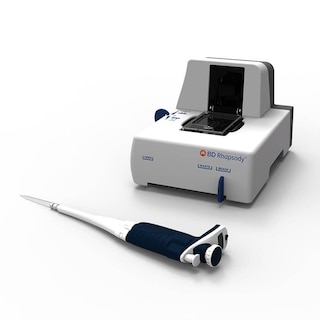-
Your selected country is
Middle East / Africa
- Change country/language
Old Browser
This page has been recently translated and is available in French now.
Looks like you're visiting us from {countryName}.
Would you like to stay on the current country site or be switched to your country?


Oligo Hamster Anti-Mouse CD54
Regulatory Status Legend
Any use of products other than the permitted use without the express written authorization of Becton, Dickinson and Company is strictly prohibited.
Preparation And Storage
Recommended Assay Procedures
Put all BD® AbSeq Reagents to be pooled into a Latch Rack for 500 µL Tubes (Thermo Fisher Scientific Cat. No. 4900). Arrange the tubes so that they can be easily uncapped and re-capped with an 8-Channel Screw Cap Tube Capper (Thermo Fisher Scientific Cat. No. 4105MAT) and the reagents aliquoted with a multi-channel pipette.
BD® AbSeq tubes should be centrifuged for ≥ 30 seconds at 400 × g to ensure removal of any content in the cap/tube threads prior to the first opening.
Product Notices
- This reagent has been pre-diluted for use at the recommended volume per test. Typical use is 2 µl for 1 × 10^6 cells in a 200-µl staining reaction.
- The production process underwent stringent testing and validation to assure that it generates a high-quality conjugate with consistent performance and specific binding activity. However, verification testing has not been performed on all conjugate lots.
- Please refer to bd.com/genomics-resources for technical protocols.
- Caution: Sodium azide yields highly toxic hydrazoic acid under acidic conditions. Dilute azide compounds in running water before discarding to avoid accumulation of potentially explosive deposits in plumbing.
- Source of all serum proteins is from USDA inspected abattoirs located in the United States.
- Illumina is a trademark of Illumina, Inc.
- Please refer to http://regdocs.bd.com to access safety data sheets (SDS).
- For U.S. patents that may apply, see bd.com/patents.
Companion Products






The 3E2 monoclonal antibody specifically binds to CD54 (ICAM-1), a 95-kDa member of the Ig superfamily found on lymphocytes, vascular endothelium, high endothelial venules, epithelial cells, macrophages, and dendritic cells. ICAM-1 is a ligand for LFA1 (CD11a/CD18) and Mac-1 (CD11b/CD18). Its expression is upregulated upon stimulation by inflammatory mediators such as cytokines and LPS. Studies with mouse Icam1-transfected antigen-presenting cells, with CD54-blocking antibodies, and in CD54-deficient mice indicate that CD54 participates in inflammatory reactions and antigen-specific immune responses. In addition, there is evidence that CD54 is a receptor involved in MHC-non-restricted responses to weakly immunogenic tumor cells. The 3E2 antibody has been reported to block in vitro and in vivo intracellular adhesion events involved in immune responses.
Development References (12)
-
Gonzalo JA, Martinez C, Springer TA, Gutierrez-Ramos JC. ICAM-1 is required for T cell proliferation but not for anergy or apoptosis induced by Staphylococcus aureus enterotoxin B in vivo. Int Immunol. 1995; 7(10):1691-1698. (Clone-specific: Flow cytometry). View Reference
-
Isobe M, Yagita H, Okumura K, Ihara A. Specific acceptance of cardiac allograft after treatment with antibodies to ICAM-1 and LFA-1. Science. 1992; 255(5048):1125-1127. (Biology). View Reference
-
Kelly KJ, Williams WW Jr, Colvin RB, et al. Intercellular adhesion molecule-1-deficient mice are protected against ischemic renal injury. J Clin Invest. 1996; 97(4):1056-1063. (Biology). View Reference
-
Masten BJ, Yates JL, Pollard Koga AM, Lipscomb MF. Characterization of accessory molecules in murine lung dendritic cell function: roles for CD80, CD86, CD54, and CD40L. Am J Respir Cell Mol Biol. 1997; 16(3):335-342. (Clone-specific). View Reference
-
Nishio M, Podack ER. Rapid induction of tumor necrosis factor cytotoxicity in naive splenic T cells by simultaneous CD80 (B7.1) and CD54 (ICAM-1) co-stimulation. Eur J Immunol. 1996; 26(9):2160-2164. (Biology). View Reference
-
Nishio M, Spielman J, Lee RK, Nelson DL, Podack ER. CD80 (B7.1) and CD54 (intracellular adhesion molecule-1) induce target cell susceptibility to promiscuous cytotoxic T cell lysis. J Immunol. 1996; 157(10):4347-4353. (Biology). View Reference
-
Scheynius A, Camp RL, Pure E. Reduced contact sensitivity reactions in mice treated with monoclonal antibodies to leukocyte function-associated molecule-1 and intercellular adhesion molecule-1. J Immunol. 1993; 150(2):655-663. (Clone-specific: Flow cytometry, Inhibition, In vivo exacerbation). View Reference
-
Scheynius A, Camp RL, Pure E. Unresponsiveness to 2,4-dinitro-1-fluoro-benzene after treatment with monoclonal antibodies to leukocyte function-associated molecule-1 and intercellular adhesion molecule-1 during sensitization. J Immunol. 1996; 154(5):1804-1809. (Biology). View Reference
-
Siu G, Hedrick SM, Brian AA. Isolation of the murine intercellular adhesion molecule 1 (ICAM-1) gene. ICAM-1 enhances antigen-specific T cell activation. J Immunol. 1989; 143(11):3813-3820. (Biology). View Reference
-
Springer TA. Adhesion receptors of the immune system. Nature. 1990; 346(6283):425-434. (Biology). View Reference
-
Springer TA. Traffic signals for lymphocyte recirculation and leukocyte emigration: the multistep paradigm. Cell. 1994; 76(2):301-314. (Biology). View Reference
-
Xu H, Gonzalo JA, St Pierre Y, et al. Leukocytosis and resistance to septic shock in intercellular adhesion molecule 1-deficient mice. J Exp Med. 1994; 180(1):95-109. (Clone-specific: Flow cytometry, Immunohistochemistry). View Reference
Please refer to Support Documents for Quality Certificates
Global - Refer to manufacturer's instructions for use and related User Manuals and Technical data sheets before using this products as described
Comparisons, where applicable, are made against older BD Technology, manual methods or are general performance claims. Comparisons are not made against non-BD technologies, unless otherwise noted.
For Research Use Only. Not for use in diagnostic or therapeutic procedures.
Report a Site Issue
This form is intended to help us improve our website experience. For other support, please visit our Contact Us page.